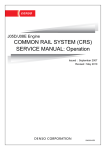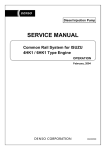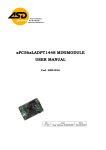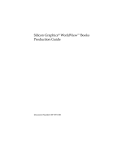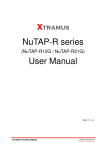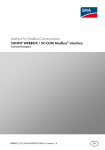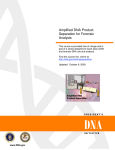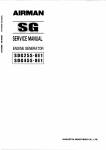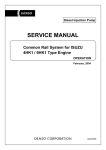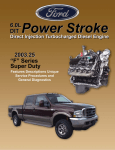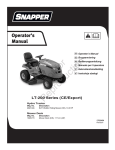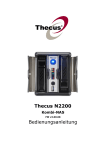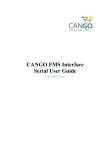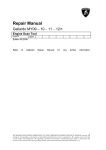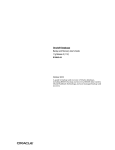Download Common Rail System (CRS) Service Manual - Service
Transcript
For Authorized Service Dealers Only ISUZU N-Series 4HK1 Engine Common Rail System (CRS) Service Manual Issued : November 2011 50000057E © 2011 by DENSO CORPORATION All rights reserved. This material may not be reproduced or copied, in whole or in part, without the written permission of DENSO Corporation. Table of Contents Table of Contents Operation Section 1. Applicable Vehicles and Parts Information 1.1 Outline . . . . . . . . . . . . . . . . . . . . . . . . . . . . . . . . . . . . . . . . . . . . . . . . . . . . . . . . . . . . . . . . . . . . . . . . . . . . . . . . 1-1 1.2 Applicable Vehicle . . . . . . . . . . . . . . . . . . . . . . . . . . . . . . . . . . . . . . . . . . . . . . . . . . . . . . . . . . . . . . . . . . . . . . . 1-1 1.3 List of Primary Parts . . . . . . . . . . . . . . . . . . . . . . . . . . . . . . . . . . . . . . . . . . . . . . . . . . . . . . . . . . . . . . . . . . . . . 1-2 2. Common Rail System (CRS) 2.1 CRS Outline. . . . . . . . . . . . . . . . . . . . . . . . . . . . . . . . . . . . . . . . . . . . . . . . . . . . . . . . . . . . . . . . . . . . . . . . . . . . 1-3 3. Supply Pump 3.1 Outline . . . . . . . . . . . . . . . . . . . . . . . . . . . . . . . . . . . . . . . . . . . . . . . . . . . . . . . . . . . . . . . . . . . . . . . . . . . . . . . . 1-4 3.2 3.3 3.4 4. Rail 4.1 Outline . . . . . . . . . . . . . . . . . . . . . . . . . . . . . . . . . . . . . . . . . . . . . . . . . . . . . . . . . . . . . . . . . . . . . . . . . . . . . . . . 1-9 4.2 Rail Pressure Sensor. . . . . . . . . . . . . . . . . . . . . . . . . . . . . . . . . . . . . . . . . . . . . . . . . . . . . . . . . . . . . . . . . . . . . 1-9 4.3 5. Injectors 5.1 Outline . . . . . . . . . . . . . . . . . . . . . . . . . . . . . . . . . . . . . . . . . . . . . . . . . . . . . . . . . . . . . . . . . . . . . . . . . . . . . . . 1-11 6. Control System Parts 6.1 Engine ECU. . . . . . . . . . . . . . . . . . . . . . . . . . . . . . . . . . . . . . . . . . . . . . . . . . . . . . . . . . . . . . . . . . . . . . . . . . . 1-13 6.2 7. Exhaust Gas Treatment System 7.1 Outline . . . . . . . . . . . . . . . . . . . . . . . . . . . . . . . . . . . . . . . . . . . . . . . . . . . . . . . . . . . . . . . . . . . . . . . . . . . . . . . 1-16 7.2 7.3 8. Diagnostic Trouble Codes (DTC) 8.1 DTC List. . . . . . . . . . . . . . . . . . . . . . . . . . . . . . . . . . . . . . . . . . . . . . . . . . . . . . . . . . . . . . . . . . . . . . . . . . . . . . 1-21 9. Control System Component Information 9.1 Engine ECU Terminal Layout Diagrams . . . . . . . . . . . . . . . . . . . . . . . . . . . . . . . . . . . . . . . . . . . . . . . . . . . . . 1-27 9.2 Connector Diagram . . . . . . . . . . . . . . . . . . . . . . . . . . . . . . . . . . . . . . . . . . . . . . . . . . . . . . . . . . . . . . . . . . . . . 1-29 Table of Contents Operation Section 1– 1 1. Applicable Vehicles and Parts Information 1.1 Outline As a result of a model change to the ISUZU 4HK1 engine beginning from May 2010, the Common Rail System (CRS) has also changed. This manual describes items specific to the parts used in the CRS for the 4HK1 engine. For CRS basics, refer to the "COMMON RAIL SYSTEM SERVICE MANUAL -OPERATION (Doc ID: 00400534EA)." Compliance with Exhaust Gas Regulations The CRS for the 4HK1 engine has undergone the following improvements to comply with US10 exhaust gas regulations. Combustion Improvements • System pressure: Increased to 200 MPa • Supply pump: Operating pressure of 200 MPa, uses positive pressure system • Rail: Operating pressure of 200 MPa • Injectors: Uses the G3 type Improved Post-Processing • Particulate Matter (PM) reduction: Diesel Particulate Filter (DPF) • NOx Reduction: Urea Selective Catalytic Reduction (SCR) 1.2 Applicable Vehicle Vehicle Manufacturer ISUZU Vehicle Name Engine Type Exhaust Volume N SERIES 4HK1 5.2 L Production Start Date May 2010 Operation Section 1– 2 1.3 List of Primary Parts DENSO Part Num- Manufacturer Part ber Number Supply Pump 294000-112# 8-98081771-2 Rail 095440-155# 8-98081768-0 Injector 295050-032# 8-98110607-2 Engine ECU 275800-875# 8-98160981-2 Crankshaft Position Sensor 949979-031# 8-97606943-0 Cylinder Recognition Sensor 949979-169# 8-98019024-0 Fuel Pressure Sensor 499000-829# 8-98105928-0 265600-125# 8-98004329-0 DPF Side 265600-126# 8-98004330-0 SCR Side 104990-101# 8-97359985-2 Part Name Exhaust Gas Temperature Sensor Exhaust Gas Temperature Sensor Differential Pressure Sensor Remarks HP4 Supply Pump G3 Type Operation Section 1– 3 2. Common Rail System (CRS) 2.1 CRS Outline The CRS for the ISUZU 4HK1 engine uses the following fuel flow path to prevent air from mixing with the fuel. The feed pump for the supply pump draws in fuel that is then initially sent to a main filter outside of the supply pump. Air inside the fuel is released from the air bleed valve on the main filter. Next, the fuel is returned again to the supply pump, and then sent to the rail under high pressure. Fuel Temperature Vehicle Speed Accelerator Position Boost Pressure Intake Air Temperature Coolant Temperature Crankshaft Position Injector Engine ECU Rail Pressure Sensor Cylinder Recognition Signal Pressure Limiter Intake Air Mass Rail Suction Control Valve (SCV) Supply Pump Sub-Filter (Negative Pressure Type) to Fuel Addition Valve (DPF) Suction Air Bleed Valve Fuel Temperature Sensor Fuel Tank Main Filter (Positive Pressure Type) Discharge Feed Return Conventional Supply Pump to Rail Supply Pump Fuel Filter Fuel Tank Q006718E 1– 4 Operation Section 3. Supply Pump 3.1 Outline The supply pump used with the ISUZU 4HK1 engine is an HP3 type adapted to positive pressure filter use. In comparison to conventional supply pumps, the 4HK1 engine supply pump includes a feed pump outlet port, and main filter pump inlet port. Positive pressure is applied to the main filter by sending fuel from the feed pump to the main filter. In addition, the supply pump uses a normally open SV3 type Suction Control Valve (SCV). Fuel Inlet (from Main Filter) Suction Control Valve (SCV) Suction Control Valve (SCV) Fuel Outlet (Overflow, to Fuel Tank) Fuel Outlet (to Main Filter) Fuel Outlet (Overflow, to Fuel Tank) Supply Pump Adapted to Positive Pressure Filter Use Fuel Inlet (from Sub-Filter) Fuel Temperature Sensor Fuel Inlet Conventional Supply Pump Q006719E Operation Section 1– 5 The 4HK1 engine CRS has been adapted to positive pressure filter use to achieve the following effects: • Stabilize the fuel supply by placing the fuel filter under positive pressure • Suppress filter clogs and increasing filter life • Reduce diagnostic abnormalities caused by pressure fluctuations that arise when air intermixing is suppressed Rear Cover A rear cover has been added to supply pumps adapted to positive pressure filters since the fuel drawn into the supply pump is sent to an external main filter. Rear cover construction features the following items: • A relief valve to adjust the fuel returning to the supply pump • A check valve to increase priming performance to the newly added fuel flow path (i.e., to the main filter) Feed Pump The feed pump cover and feed pump plate have changed. Moreover, the discharge port on the feed pump plate is blocked off. Feed Pump Plate Discharge-Side Port Obstruction Feed Pump Cover Rear Cover Rear Cover Relief Valve Check Valve Q006720E 1– 6 Operation Section In a conventional supply pump, fuel is sent directly through the following flow path: feed pump plunger chamber SCV rail. However, in the supply pump adapted to positive pressure filter use, the fuel flow path is as follows: feed pump main filter SCV plunger chamber rail. Flow Path for Supply Pump Adapted to Positive Pressure Filter Use Flow Path for a Conventional Supply Pump Q004898E Operation Section 1– 7 The SCV used with the ISUZU 4HK1 engine is a normally open SV3 type. The SV3 type has the following features: • A more compact design compared to the SV1 type due to a smaller solenoid • Improved valve sliding performance Solenoid Valve Body Valve Spring Needle Valve Armature <Cross-Sectional Diagram> <External View> Q006721E Plunger Needle Valve Supply Pump Short Duty ON Duration Large Valve Opening Large Suction Quantity Large Valve Opening Cylinder Long Duty ON Duration Small Valve Opening Small Suction Quantity Small Valve Opening Cylinder Q006722E Operation Concept Diagram 1– 8 Operation Section The fuel temperature sensor detects the fuel temperature, and sends corresponding signals to the engine ECU. The ECU then uses the signal information to calculate an injection correction suited to the fuel temperature. <Reference: Temperature/Resistance Characteristics> Temperature ( ) Resistance (k ) Fuel Temperature Sensor Q006723E Operation Section 1– 9 4. Rail 4.1 Outline Compared to a conventional rail, the rail used with the ISUZU 4HK1 engine is adapted to high pressure (200 MPa). The rail distributes fuel sent from the supply pump to each injector. Fuel Inlet Pressure Limiter to Injectors Rail Pressure Sensor Q006724E 4.2 Rail Pressure Sensor The rail pressure sensor detects fuel pressure inside the rail. There are two rail pressure sensors to provide a backup in case of a malfunction. In addition, the output signal for each sensor system is offset. Rail Pressure (MPa) Q006725E 1– 10 Operation Section The pressure limiter used with the ISUZU 4HK1 engine is adapted to a pressure of 200 MPa. The pressure limiter opens to release fuel from the rail when the internal pressure becomes abnormally high. Pressure limiter construction and characteristics are as shown in the figure below. Housing Spring Valve Open Valve to Fuel Tank from Rail Closed Valve Valve Body Q004915E Operation Section 1– 11 5. Injectors 5.1 Outline The 4HK1 engine CRS uses G3 type injectors. G3 injectors are designed to support a system pressure of 200 MPa, to improve responsiveness, and to increase resistance against foreign material adherence to the nozzle. G3 type operation and QR code (ID code) injection quantity corrections are the same as for G2 type with conventional QR codes. (However, the QR code correction points differ.) QR Code ID Codes High-Pressure Fuel (from Rail) Solenoid Valve Control Chamber Command Piston Pressure Pin Nozzle Spring Nozzle Needle Q006726E. Operation Section Injection Quantity Q 1– 12 10 Correction Points Actuation Pulse Width TQ Q006727E Correction Points Using QR Codes Operation Section 1– 13 6. Control System Parts 6.1 Engine ECU The engine ECU conducts overall engine control. The engine ECU for the ISUZU 4HK1 engine is mounted in the cabin, and contains a built-in injector actuation circuit, thereby eliminating the Electronic Drive Unit (EDU). Q006728 1– 14 Operation Section (1) Crankshaft Position Sensor (NE Sensor) and Cylinder Recognition Sensor (G Sensor) • The 4HK1 engine CRS uses a crankshaft position sensor (NE sensor) and cylinder recognition sensor (G sensor). Both sensors are Magnetic Resistance Element (MRE) types. Crank Position Sensor (NE Sensor) Cylinder Recognition Sensor (G Sensor) Q006729E Crankshaft Position Sensor The crankshaft position sensor detects the crankshaft angle. The pulsar has 56 teeth (separated at 6° intervals, with four missing teeth to detect Top Dead Center [TDC] for cylinders no. 1 and no. 4). <Circuit Diagram> Engine ECU Sensor Four Missing Teeth NE Input Circuit Pulsar Q006730E Cylinder Recognition Sensor (G) The cylinder recognition sensor identifies the engine cylinders. The pulsar has five teeth (recognition of TDC for each cylinder + recognition of cylinder no. 1). Pulsars Cylinder No. 1 Recognition <Circuit Diagram> Engine ECU Sensor G Input Circuit Q006731E Operation Section 1– 15 • The 4HK1 engine CRS is equipped with a fuel pressure sensor to detect fuel pressure between the feed pump outlet on the supply pump, and the main filter. Sensor output determines correction control for the fuel addition valve, and whether a main filter clog exists. The fuel pressure sensor is a semiconductor type device that uses a characteristic of silicone crystals in which electrical resistance changes when the pressure applied to the crystals is varied. Output Voltage (V) Engine ECU Fuel Pressure (MPa) Q006732E (3) Engine Oil Pressure Sensor • The engine oil pressure sensor detects engine oil pressure. If engine oil pressure reaches an abnormally high value, the sensor stops the engine. Output Voltage (V) Engine ECU Q006733E 1– 16 Operation Section 7. Exhaust Gas Treatment System 7.1 Outline The 4HK1 engine CRS adds a Diesel Particulate Filter (DPF) to eliminate Particulate Matter (PM), and uses urea Selective Catalytic Reduction (SCR) to reduce NOx. Urea SCR adds urea to the exhaust gas, and the SCR catalyst reduces the NOx. The exhaust gas temperature sensor and differential pressure sensor used in the 4HK1 engine exhaust gas treatment system are made by DENSO. Fuel Addition Valve Oxidation Catalyst Exhaust Gas Temperature Sensor Differential Pressure Sensor DPF Exhaust Gas Temperature Sensor Urea SCR Catalyst Oxidation Catalyst Urea SCR ECU Urea Feed Device Urea Addition Valve Urea Tank Q006734E Operation Section Part 1– 17 Function Conducts HC and CO purification, as well as NO x oxidation (NO Å® NO2). (Adding NO2 promotes NOx reduction.) Diesel Particulate Filter (DPF) Traps PM and conducts PM oxidation treatment. Urea SCR Catalyst Oxidation Catalyst (Post-Urea SCR Catalyst) Exhaust Gas Temperature Sensor (DPF) Uses urea added to the exhaust gas to reduce the NOx. Purifies any urea (ammonia) not used in NOx reduction. Measures the exhaust gas temperature at the DPF, and then outputs corresponding signals to the engine ECU. The engine ECU controls DPF regeneration based on the aforementioned signals. Measures the difference in exhaust gas pressure across the DPF, and then outputs corresponding signals to the engine ECU. The engine ECU calcu- Differential Pressure Sensor lates the quantity of PM accumulated in the DPF based on the aforementioned signals, and then determines whether or not to conduct PM regeneration. Mounted upstream of the urea SCR catalyst to measure the NOx concentra- NOx Sensor Exhaust Gas tion in the exhaust gas before passing through the catalyst. Temperature Mounted upstream of the urea SCR catalyst to measure the exhaust gas Sensor (Urea SCR) temperature before passing through the catalyst. Urea Addition Valve Adds urea to the exhaust gas based on signals from the urea SCR ECU. Urea Feed Device Draws urea from the urea tank that is then pumped to the urea addition valve. The pumping pressure is based on control from the urea SCR ECU. Calculates the optimal urea addition quantity based on signals from the NOx sensor, exhaust gas temperature sensor (urea SCR), etc. Controls the urea Urea SCR ECU feed device and urea addition valve so that the optimal amount of urea is added to the system. In addition, outputs urea SCR system diagnosis to the engine ECU. Exhaust Gas Temperature Sensor The exhaust gas temperature sensor detects the exhaust gas temperature in the vicinity of the catalyst. A thermistor is used for actual temperature detection. Temperature - Resistance Characteristics 265600-125# (DPF Side) 265600-126# (SCR Side) Temperature Resistance Value *The only difference between the two sensors is the thread pitch. (The specifications are the same.) Q006735E 1– 18 Operation Section The differential pressure sensor detects the difference in exhaust gas pressure across the DPF. The sensor is a semiconductor type device that uses a characteristic of silicone crystals in which electrical resistance changes when the pressure applied to the crystals is varied. Engine ECU Fuel Pressure (kPa) Q006736E. Operation Section 1– 19 The following is an outline of PM regeneration control in the 4HK1 engine CRS. PM regeneration can be performed both manually and automatically. PM regeneration is normally conducted automatically when the system determines that a set quantity of PM has accumulated in the DPF. However, there are cases in which PM regeneration does not take place automatically due to driving conditions. When PM is not being regenerated automatically, the following two indicator lights flash: 1) the light built into the switch for the exhaust gas purification device, and 2) the exhaust gas purification device light located inside the meter panel. These indicator lights are alerts prompting the user to press the exhaust gas purification device switch and begin manual PM regeneration. When an alert occurs, press the exhaust gas purification device switch near the driver's seat to manually start PM regeneration. Control The accumulated quantity of PM is inferred from the differential pressure sensor signals (difference in exhaust gas pressure across the DPF). PM regeneration occurs when the accumulated PM quantity is determined to be high (a large differential pressure across the DPF). In PM regeneration mode, after-injection has been added to the normal injection pattern (pre-injection, main injection). Injection is also performed from the fuel addition valve. The actual control sequence adds the after-injection first to raise the catalyst temperature. Next, when the catalyst temperature reaches a set value, injection occurs from the fuel addition valve, and full-scale regeneration begins. Regeneration judgments and injection control are conducted by inferring the catalyst temperature base on signals from the exhaust gas temperature sensors before and after each catalyst. Top Dead Center (TDC) Main Injection Pre-Injection Q006737E. 1– 20 Operation Section Urea SCR adds an aqueous urea solution to the exhaust gas, and the SCR catalysts reduces the NOx. The aqueous urea solution is not used as is during NOx reduction. In actuality, the ammonia produced when the solution undergoes hydrolysis is used to reduce the NOx. A system that contains an aqueous urea solution is used due to the inherent danger of mounting a source of ammonia directly on the vehicle. The urea SCR ECU controls the urea SCR based primarily on the exhaust gas temperature and the NO x concentration in the exhaust gas. Ammonia is generated from the aqueous urea solution by using the exhaust gas heat to conduct hydrolysis. As such, the following values are required to add the solution from the urea addition valve into the exhaust gas: 1) the quantity of urea that will undergo hydrolysis, calculated from the exhaust gas temperature; and 2) the optimal quantity of solution to be added, calculated from the NOx concentration in the exhaust gas. (1) NOx Reduction Mechanism • An oxidation catalyst prior to the urea SCR that initially oxidizes NO into NO2. This catalyst promotes the NOx reduction reaction when NO 2 increases. • Adds the aqueous urea solution to the exhaust gas after it has passed through the DPF. The added aqueous urea solution is hydrolysized by exhaust gas heat and converted into ammonia and CO2. • Uses the ammonia generated from the aqueous urea solution to reduce and convert the NOx into N2 (nitrogen) and H 2O (water). • Purifies any ammonia not used in NO x reduction. Oxidation Catalyst NNO Oxidized into NO2 Aimed at the NOX reduction reaction (1) in the urea SCR catalyst. DPF Urea Addition Valve Ammonia Generation Urea SCR Catalyst NOX Reduction An aqueous urea solution is hydrolysized u sing the exhaust gas heat to generate ammonia. Four reduction reactions are triggered in the catalyst to reduce the NOX. However, the reaction (1) is the most efficient. Reaction in the Urea SCR Catalyst Reduction Reaction Catalyst Q004928E Operation Section 1– 21 8. Diagnostic Trouble Codes (DTC) 8.1 DTC List DTC Detection Item P000F Rail pressure too low P0016 Crankshaft position-intake camshaft position correlation bank 1 P0027 Exhaust brake valve stick Exhaust throttle valve stick P003A P0045 Variable Geometry Turbo (VGT) module wiping too wide error VGT module motor circuit short and GND short/position control abnormal/power supply voltage high error P0046 VGT module control response abnormal P006E VGT module power supply voltage low error P0079 Exhaust throttle GND short P007C Charge Air Cooler (CAC) out temperature sensor circuit low voltage P007D CAC out temperature sensor circuit high voltage P0080 Exhaust throttle +B short P0087 Rail pressure low during power enrichment Rail pressure too high P0088 Fuel pressure regulator 1 performance P0089 Rail pressure exceeds high upper limit P0091 Rail fuel pressure regulator solenoid 1 control circuit P0092 Rail fuel pressure regulator solenoid 1 control circuit P0093 Rail fuel pressure low during idle or deceleration fuel cut-off P0097 Intake manifold temperature sensor 2 circuit low P0098 Intake manifold temperature sensor 2 circuit high P00AF VGT module memory access abnormal Mass Air Flow (MAF) meter rationality low P0101 MAF meter rationality high P0102 MAF meter circuit low P0103 MAF meter circuit high P0112 Intake air temperature sensor circuit low P0113 Intake air temperature sensor circuit high P0116 Engine coolant temperature sensor performance P0117 Engine coolant temperature sensor circuit low P0118 Engine coolant temperature sensor circuit high P011C CAC temperature outlet sensor surveillance P0126 Engine coolant temperature insufficient for stable operation 1– 22 Operation Section DTC Detection Item P0128 Engine coolant temperature below thermostat regulating temperature P0171 Injector quantity lean performance P0172 Injector quantity rich performance P0181 Fuel temperature sensor intermediate hold P0182 Fuel temperature sensor A circuit low P0183 Fuel temperature sensor A circuit high Rail pressure sub-sensor signal keeping the middle range P018B Rail pressure sub-sensor performance 1 Rail pressure sub-sensor performance 2 P018C Rail pressure sub-sensor circuit low voltage P018D Rail pressure sub-sensor circuit high voltage Rail pressure sensor signal keeping the middle range P0191 Rail pressure sensor performance 1 Rail pressure sensor performance 2 P0192 Rail pressure sensor circuit low voltage P0193 Rail pressure sensor circuit high voltage P0201 TWV 1 output open load injector #1 coil open P0202 TWV 4 output open load injector #2 coil open P0203 TWV 2 output open load injector #3 coil open P0204 TWV 3 output open load injector #4 coil open P020A Injector #1 quantity increase failure Injector #1 quantity decrease failure P020B Injector #2 quantity increase failure Injector #2 quantity decrease failure P020C Injector #3 quantity increase failure Injector #3 quantity decrease failure Injector #4 quantity increase failure P020D Injector #4 quantity decrease failure Engine overrun P0219 Engine overrun 2 P0234 Turbo/supercharger engine overboost P0237 Turbo/supercharger boost sensor A circuit low P0238 Turbo/supercharger boost sensor A circuit high P0261 Injector #1 (TWV 1) load short (coil short/terminal short) P0264 Injector #4 (TWV 4) load short (coil short/terminal short) P0267 Injector #2 (TWV 2) load short (coil short/terminal short) P0270 Injector #3 (TWV 3) load short (coil short/terminal short) P0299 Turbo/supercharger engine underboost P02E2 ITHR DC motor output open load motor open load Operation Section DTC P02E3 Detection Item ITHR DC motor output short to battery/short to GND motor short Intake throttle stuck closed P02E7 Intake throttle stuck open Intake throttle open learning error Intake throttle closed learning error P02E8 Intake throttle position too low P02E9 Intake throttle position too high P0300 Engine misfire detected P0301 Cylinder 1 misfire detected P0302 Cylinder 2 misfire detected P0303 Cylinder 3 misfire detected P0304 Cylinder 4 misfire detected P0335 Crankshaft position sensor A circuit P0336 Crankshaft position sensor A performance P0340 Intake camshaft position sensor circuit bank 1 P0341 Intake camshaft position sensor performance bank 1 P0381 Wait to start light control module internal circuit (short to BATT) Wait to start light control module internal circuit (open load/short to GND) P0401 MAF meter performance (Exhaust Gas Recirculation [EGR] negative deviation) P0402 MAF meter performance (EGR positive deviation) EGR duty error P0403 EGR brushless motor circuit too high EGR brushless motor circuit too low EGR brushless motor circuit too open P0404 EGR open position performance P0405 EGR brushless motor position sensor signal invalid low P0406 EGR brushless motor position sensor signal invalid high P040B EGR gas sensor performance P040C EGR gas temperature too low P040D EGR gas temperature too high P041B EGR gas sensor 2 performance P041C EGR gas temperature 2 too low P041D EGR gas temperature 2 too high P0420 DPF deterioration 2 P042E EGR closed position performance P046C EGR closed learning P0500 Vehicle speed sensor circuit P0506 Low target idle speed P0507 High target idle speed 1– 23 1– 24 Operation Section DTC Detection Item P0512 Starter switch short to BATT P0522 Oil pressure sensor signal too low P0523 Oil pressure sensor signal too high P0545 Exhaust gas temperature before oxidation catalyst too low P0546 Exhaust gas temperature before oxidation catalyst too high P0562 System low voltage status determination P0563 System high voltage status determination P0567 Cruise control resume switch determination P0568 Cruise control set switch determination P0571 Cruise control brake switch determination P0602 QR code error P0606 Engine ECU processor (main CPU fault) Engine ECU processor (watchdog IC fault) P062F Control module long term memory performance P0642 Battery 5 V reference 1 circuit low P0643 Battery 5 V reference 1 circuit high Glow plug module control circuit P064C Glow plug module INTST Glow plug module MEEPST P0650 Malfunction Indicator Lamp (MIL) control circuit monitoring (short to BATT) MIL control circuit monitoring (open load/short to GND) P0652 Battery 5 V reference 2 circuit low P0653 Battery 5 V reference 2 circuit high P0671 Cylinder 1 glow plug circuit P0672 Cylinder 2 glow plug circuit P0673 Cylinder 3 glow plug circuit P0674 Cylinder 4 glow plug circuit P0687 Main relay diagnostics; main relay stuck closed P0698 Battery 5 V reference 3 circuit low P0699 Battery 5 V reference 3 circuit high P0700 Transmission control module requested MIL illumination monitoring P1072 Compressor outlet temperature sensor circuit low voltage P1073 Compressor outlet temperature sensor circuit high voltage P1076 CAC in temperature sensor circuit low voltage P1077 CAC in temperature sensor circuit high voltage P1078 CAC temperature inlet sensor surveillance Supply pump protection P1085 P1102 Supply pump exchange Rail pressure sensor performance (correlation abnormal) Operation Section DTC Detection Item P1125 Accelerator Pedal Position (APP) system P113A O2 signal of NOx sensor rationality P1236 CAC performance P1259 Rail fuel pressure low during power enrichment P1261 Capacitor charge-up circuit malfunction (insufficient charge) Capacitor charge-up circuit malfunction (excessive charge) P1463 DeNOx-DS error for SVS lighting request P1470 DPF exhaust presser performance P1471 DPF regeneration insufficiency P160B Q DATA cross check error P2002 DPF deterioration (II) P2032 Exhaust gas temperature before DPF too low P2033 Exhaust gas temperature before DPF too high P20C9 DeNOx-DS error for MIL lighting request P20CB Exhaust injector circuit GND short/open load P20CC Exhaust injector circuit BATT short Exhaust injector circuit load short P20CF P20DE Exhaust injector performance Exhaust injector pressure sensor performance high Exhaust injector pressure sensor performance low P20DF Exhaust injector pressure sensor circuit low voltage P20E0 Exhaust injector pressure sensor circuit high voltage P20E2 Exhaust gas temperature sensor surveillance P2122 Accelerator pedal position sensor no. 1 low range P2123 Accelerator pedal position sensor no. 1 high range P2127 Accelerator pedal position sensor no. 2 low range P2128 Accelerator pedal position sensor no. 2 high range P2138 Accelerator pedal position sensor no. 1 & 2 correlation check P2146 COM 1 output open load; Both TWV 1 and 3 (and 5) open load P2147 COM 1 output short to GND; TWV 1 or 3 (or 5) output short to GND P2148 COM 1 output short to BATT; TWV 1 or 3 (or 5) output short to BATT P2149 COM 2 output open load; Both TWV 2 or 4 (or 6) open load P2150 COM 2 output short to GND; TWV 2 or 4 (or 6) output short to GND P2151 COM 2 output short to BATT; TWV 2 or 4 (or 6) output short to BATT P2199 THA-THA 2 sensor surveillance P2227 Barometric pressure (BARO) sensor performance P2228 Barometric pressure (BARO) sensor circuit low voltage P2229 Barometric pressure (BARO) sensor circuit high voltage P2262 Turbo/supercharger engine underboost 1– 25 1– 26 Operation Section DTC P2263 Detection Item VGT slow response up side VGT slow response down side P226B P2413 Turbo/supercharger engine overboost EGR slow response ON EGR slow response OFF P2428 Exhaust gas temperature sensor before oxidation catalyst too high Exhaust gas temperature sensor before oxidation catalyst too low P244B DPF PM over accumulation P244C DPF deterioration P244D Exhaust gas temperature sensor before DPF too high Exhaust gas temperature sensor before DPF too low P2453 DPF pressure sensor performance P2454 Exhaust gas pressure reference too low P2455 Exhaust gas pressure reference too high P2457 EGR cooler inferiority P2459 DPF regeneration excessive frequency P2463 DPF trip over accumulation P254C Auxiliary engine RPM sensor circuit low P254D Auxiliary engine RPM sensor circuit high P2564 VGT hole IC sensor circuit low P2565 VGT hole IC sensor circuit high P256C Idle Air Control (IAC) valve control circuit low voltage P256D IAC valve control circuit high voltage P268A QR code not programmed U0001 CAN bus 2 reset counter overrun U0073 CAN bus reset counter overrun U0101 Lost CAN communication (CAN SOH) with TM control system U0106 Glow plug module communication failure U010C VGT module communication failure U010E DeNOx-DS communication time-out U0121 CAN ABS SOH diagnostic U0307 GPCM engine ID diagnostic Operation Section 1– 27 9. Control System Component Information 9.1 Engine ECU Terminal Layout Diagrams P/N SW ACG START ON KEY SW C Starter Relay ACC B Main Relay BATT A Accelerator Position Sensor APS2 APS1 Vehicle Speed Sensor B PTO Accelerator Position Sensor DPFSOL EXBCUT-SW PACL-VCC PACL PACL-GND Exhaust Brake PTO Disable SW Remote PTO Set Remote PTO Resume PTO Set Speed A SW PTO Set Speed B SW CAB Control Disable SW Ignore Brake/Clutch SW Cruise Main (ON/OFF) Cruise Resume/Accel Cruise Set/Coast PTO LAMP M-REL M-REL +B +B +B BATT VSS APS1-VCC APS1 APS1-GND APS2-VCC APS2 APS2-GND IDLUP-VCC IDLUP IDLUP-GND Idle Up Volume PTO SW STA-SW STA-REL IG1-SW OFF + Battery - B Starter Motor PTO Tap Down MIL GL-L CANH CANL TACHO VSOUT1 DPF Exhaust Throttle Cut Relay ABS Meter Malfunction Indicator Lamp B Glow Lamp Twisted Pair SAEJ1939-11 Compliant Twisted Pair Twisted Pair Tacho Vehicle Speed PWM Output VGS C/U AT Controller MT Vehicles Only Glow Plug Control Module EXB-SW A C Glow Plug PTODIS-SW RSET-SW RRES-SW SSPA-SW DPFD-VCC DPFD SSPB-SW CCDIS-SW DPFD-GND IGBC-SW THDOC CRM-SW THDOC-GND CRR-SW CRS-SW THCSF DPF Differential Pressure Sensor Exhaust Gas Temperature Sensor-1 (Oxidation Catalyst) Exhaust Gas Temperature Sensor-2 (SCR) THCSF-GND PTO Tap Up A A Exhaust Soknoid Valve PTOEN-SW LOCOL-SW PTOEN-REL IDESEN-SW PTOFB-SW Enable Relay PTO Feedback SW IDM1 IDM2 Magnetic Valve Brake1 (Normally Open) BK1-SW COMMON1 Brake2 (Normally Closed) BK2-SW TWV-A Clutch SW (MT Vehicles) TWV-C CL-SW DPF Regeneration DPFREG-SW COMMON2 Air Conditioner AC-SW TWV-B TWV-D Magnetic Clutch :Option Circuit Terminals with no external circuit commands written in parenthesis are auxiliary circuits. Low Coolant Level SW Idle Engine Stop Enable SW M+ M- Diesel Throttle DC Motor Injector #1 Injector #4 Injector #3 Injector #2 Q006845E Operation Section 1– 28 Crankshaft Position Sensor Cylinder Recognition Sensor Manifold Absolute Pressure sensor Rail Pressure Sensor1 NE-VCC SCVHI NE SCVHI NE-GND SCVLO G-VCC SCVLO G G-GND EXTPIP+ PB-VCC EXTPIPPBOOST PB-GND PFUEL1-VCC ISOH ISOL PFUEL1 SCV Twisted Pair Fuel Addition Valve ISO CAN SAE.CON DCU PFUEL1-GND PFUEL2-VCC Rail Pressure Sensor2 Diesel Throttle Position Sensor A Mass Air Flow Meter CAC In Temperature THCAI1 PFUEL2 THCAI1-GND PFUEL2-GND ITH-VCC THCAO1-GND ITH ITH-GND THCOT THCOT-GND MAF MAF-GND (THCAO2) THA THA-GND CAC Out Temperature Compressor Outlet Temperature (THCAO2-GND) Atmospheric Pressure Sensor (BARO) Coolant Temperature Sensor Fuel Temperature Sensor EGR Temperature Sensor (IN) EGR Temperature Sensor (OUT) Oil Pressure Sensor THW EXPS-VCC THW-GND EXPS EXPS-GND THL THL-GND Fuel Addition Valve Pressure Sensor THEGRI THEGRI-GND THEGRO EGRPOS-VCC THEGRO-GND EGRPOS-U EBM-U EGRPOS-V IMT EBM-V IMT-GND EGRPOS-W EBM-W EGRPOS-GND P-GND P-GND P-GND POIL-VCC POIL P-GND POIL-GND GND GND CASE-GND :Option Circuit Terminals with no external circuit commands written in parenthesis are auxiliary circuits. EGR Valve Drive DC Brushless Motor Power GND Power GND Power GND Power GND Signal GND Signal GND Case GND Q006846E Operation Section 1– 29 9.2 Connector Diagram Q006847 Service Division DENSO CORPORATION 1-1, Showa-cho, Kariya-shi, Aichi-ken, 448-8661, Japan



































